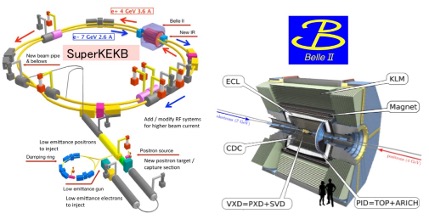High Energy Physics
The High Energy Physics (HEP) group at the University of Louisville is studying flavor physics of heavy quarks and leptons and searching for dark sector candidates at the intensity frontier with data collected by the Belle II experiment at the asymmetric electron-positron collider, the SuperKEKB, located at KEK in Tsukuba, Japan.
The High Energy Physics (HEP) group at the University of Louisville is studying flavor physics of heavy quarks and leptons and searching for dark sector candidates at the intensity frontier with data collected by the Belle II experiment at the asymmetric electron-positron collider, the SuperKEKB, located at KEK in Tsukuba, Japan.
Building upon prior experience with the previous generation B-Factory experiment BaBar, we are currently members of the Belle II Collaboration. Belle II is the next-generation flavor physics experiment operating around 10.58 Giga-electronvolts (GeV) with a mission to discover new physics using large samples of beauty and charmed hadrons, as well as tau leptons. Belle II makes precise measurements of the parameters of the electroweak interaction, studies exotic hadrons, and searches for new phenomena beyond the Standard Model of particle physics.
Since the October 2018 Belle II General Meeting, our group has been steadily involved in searches of new physics with tau leptons, online operations, upgrade of the data-acquisition system and data-quality monitoring of the Klong and muon (KLM) detector, Geant4 simulation toolkit upgrades, Monte Carlo Event generators and event type database management.
In June 2022, the SuperKEKB achieved a new luminosity world record of 4.7x1034cm−2s−1 before a long shutdown period. Data taking resumed in March 2024 after upgrades to both the accelerator and the detector. Since start of data-taking in March 2019, Belle II has collected 531 fb-1 of data by the Summer of 2024, with a long-term goal of collecting hundred times more data.
Currently, the HEP group at University of Louisville group is searching for dark sector candidates and charge lepton flavor violation involving tau leptons at Belle II. The principal focus of the group is to search for new physics with tau leptons. The group is also involved in averaging fundamental properties of the tau lepton, such as mass, lifetime, branching fractions and upper limits, on behalf of the Heavy Flavor Averaging Group and the Particle Data Group. The group hosted the 17th International Workshop on Tau Lepton Physics (Tau2023) from 4th to 8th Dec 2023.
Faculty
- Swagato Banerjee, Ph.D. (Tata Institute of Fundamental Research)
- Christopher L. Davis, Ph.D. (Oxford University)
Representative Publications
- Electron-positron, parton-parton, and photon-photon production of tau-lepton pairs: anomalous magnetic and electric dipole moments spin effects by Sw. Banerjee, A. Korchin, E Richter-Was and Z. Was, Phys. Rev. D 109 (2024) 1, 013002.
- Search for a dark leptophilic scalar produced in association with tau+tau- pairs in e+ e- annihilation at center-of-mass energies near 10.58 GeV by D. Biswas, Sw. Banerjee, et. al. (Belle collaboration), Phys. Rev. D 109 (2024) 3, 032002.
- Tau branching fractions” in “Review of particle physics by S. Navas, et. al. (Particle Data Group), Phys. Rev. D 110 (2024) 3, 030001.
- Search for a dark photon in e+e- collisions at BABAR, J.P. Lees, D. N. Brown, C. L. Davis et al. (BABAR Collaboration), Phys. Rev. Lett. 113, 201801 (2014)
- Antideuteron production in Υ(nS) decays and in e+e- → qq at 10.58 GeV, J.P. Lees, D. N. Brown, C. L. Davis et al. (BABAR Collaboration), Phys. Rev. D 89, 111102(R) (2014)
- Evidence for the baryonic decay B0 → D0 Λ Λ, J.P. Lees, D.N. Brown, C.L. Davis et al. (BABAR Collaboration), Phys. Rev. D 89, 112002 (2014)

